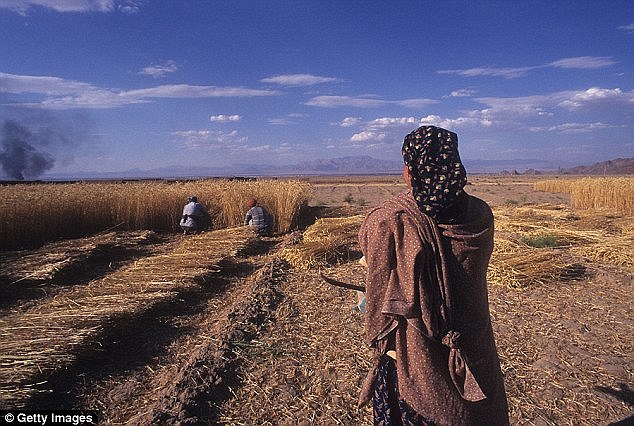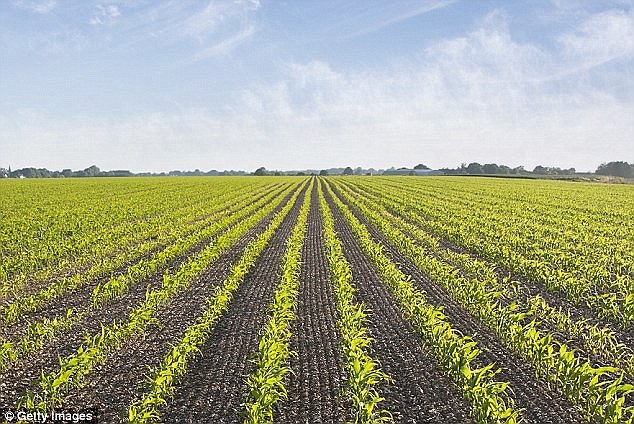The roots of farming revealed: DNA shows practice emerged independently in three populations 12,000 years ago
Study relied on genome-wide study of ancient human remains from the Near East at the dawn of agriculture 12,000 to 8,000 years ago[CN]
基于8000~12000年前农业曙光前,近东古人类遗址全基因组的研究。
Found world's first farmers came from 3 genetically-distinct communities[CN]
发现世界的第一批农民来自三个不同基因组的社区。
And farming spread in the Near East because existing groups invented or adopted farming technologies, not because they replaced another group[CN]
近东农业的发展得益于当地人种发明或采用农耕技术,而不是由于他们取代了其他人种。

The world's first farmers came from three genetically-distinct communities in the Near and Middle East, suggesting agriculture was developed in two regions independently, according to a new study. Farm workers and a crop harvest in modern Iran, are pictured[CN]
世界首批农民来自近中东基因迥异的三个社区,新的研究表明,农业分为独立的两大区。如图,伊朗农民收割庄稼图。

The study revealed farming spread in the Near East at least in part because existing groups invented or adopted farming technologies, rather than because one population replaced another, meaning agriculture has multiple roots. A filed of orderly, modern crops is shown[CN]
研究表明,近东农耕的发展至少有部分是因为当时的人种发明或采用农耕技术,而不是一个人种取代另一个人种来发展农耕,这就意味着农耕有着多重起源。
The world's first farmers came from three genetically-distinct communities in the Near and Middle East, suggesting agriculture was developed in different regions independently.[CN]
世界首批农民来自近中东基因迥异的三个不同社区,同时研究表明农业在不同区域是独立发展的。
Researchers conducted the first large-scale, genome-wide study of ancient human remains from the Near East at the dawn of agriculture 12,000 to 8,000 years ago.[CN]
研究人员首次大规模、全基因组的研究了8000~12000年前农业曙光前的近东古人类遗址。
They found farming spread in the Near East at least in part because existing groups invented or adopted farming technologies, rather than because one population replaced another.[CN]
他们发现,近东农耕的发展至少有部分是因为当时的人种发明或采用农耕技术,而不是一个人种取代另一个人种来发展农耕。
The team of experts studied two newly described groups in Iran and the Levant and a previously reported group in Anatolia, in what is now Turkey.
They wrote in the journal Nature Genetics: 'The first farmers of the southern Levant (Israel and Jordan) and Zagros Mountains (Iran) were strongly genetically differentiated, and each descended from local hunter–gatherers.'
Ron Pinhasi, associate professor of archaeology at University College Dublin and co-senior author of the study, explained: ‘Some of the earliest farming was practiced in the Levant, including Israel and Jordan, and in the Zagros mountains of Iran—two edges of the Fertile Crescent.
‘We wanted to find out whether these early farmers were genetically similar to one another or to the hunter-gatherers who lived there before so we could learn more about how the world’s first agricultural transition occurred.’
An international team of experts led by Harvard Medical School found that contrary to popular belief, the people of western Eurasia descended from four major groups: Hunter-gatherers in what is now eestern Europe, hunter-gatherers in eastern Europe and the Russian steppe, a farming group in Iran farming group one in the Levant.
David
Reich, professor of genetics at Harvard Medical School and senior
co-author of the study, said: ‘We found that the relatively homogeneous
population seen across western Eurasia today, including Europe and the
Near East, used to be a highly substructured collection of people who
were as different from one another as present-day Europeans are from
East Asians.
Iosif Lazaridis, also from Harvard Medical School, added: ‘Near East populations mixed with one another over time and migrated into surrounding regions to mix with the people living there until those initially quite diverse groups became genetically very similar.'
Before, it was difficult to study the genetic history of the Near East because the region’s warm climate has degraded much of the DNA in unearthed bones.
But the researchers overcame this problem by extracting genetic material from ear bones that can yield up to 100 times more DNA than other bones in the body.
They also used a technique called in-solution hybridization to enrich for human DNA and filter out contaminant DNA from microbes.
This combination allowed the experts to gather high quality genomic information from 44 ancient Near Easterners who lived between 14,000 and 3,400 years ago - hunter-gatherers from before the invention of farming, the first farmers themselves and their successors.
By comparing the genomes to one another as well as 240 previously studied ancient people from nearby regions and 2,600 present-day people, the researchers learned that the first farming cultures in the Levant, Iran and Anatolia were all genetically distinct.
Farmers in the Levant and Iran were genetically similar, however, to earlier hunter-gatherers who had lived in the same areas.
Dr Lazaridis said: ‘Maybe one group domesticated goats and another began growing wheat, and the practices were shared in some way.
‘These different populations all invented or adopted some facets of the farming revolution, and they all flourished.’
Over the following 5,000 years, the Near East farming groups mixed with one another and with hunter-gatherers in Europe.
Dr Reich explained: ‘All this extraordinary diversity collapsed. By the Bronze Age, populations had ancestry from many sources and broadly resembled present-day ones.’
The researchers also learned how descendants of each early farming group, even as they began to intermingle, contributed to the genetic ancestry of people in different parts of the world.
For example farmers related to the Anatolian group spread west into Europe, people related to the Levant group moved south into East Africa, people related to those in Iran or the Caucasus went north into the Russian steppe, and people related to both the farmers in Iran and hunter-gatherers from the steppe spread into South Asia.
Dr Pinhasi said: ‘The Near East was the missing link to understanding many human migrations.’
There are many things that evolved naturally in our behaviours and quite independently across the globe simply because it was the natural process of growth in our abilities as humans. This includes farming as well as building pyramids. Erik Von Daniken will have you believe that it's aliens, but in reality, the pyramid is the best and most stable shape in geometry, so naturally humans across the globe would discover it at roughly the same time. The same is true for some bird behaviours.[CN]
我们的行为中有很多事情都是自然演变,全世界独立自主地发展开来的。原因仅仅是这是我们人类能力发展的自然进程。其中包括农耕以及建造金字塔。Erik Von Daniken会告诉你那是外星人干的,但实际上金字塔是几何中最理想最稳定的模型。因而理所当然地,全球的人类都会在差不多的时间里发现这个原理。一些鸟类行为亦可照此类推。
the concept that we started to farmer a given point is erroneous - homo sapiens have probably "farmed" for tens of thousands of years promoting edible plants over non-edible this was just a continuation of that process[CN]
我们给农业下的定义里头,有个观点是错误的。智人种很可能已经尝试务农上万年把可使用的植物和不可食用的分离出来,文章所讲只是这个进程的延续。





















